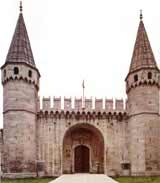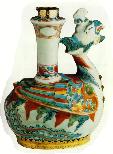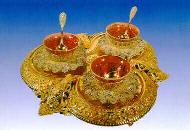Topkapi Palace
|
|
Note: Where ever you see a text written in red in this section, means that there are more information you can view about the subject in this site. You can access that info by clicking on that text. However, some of them may not work at the moment if that information is still under construction.
Brief History:
For centuries, the world was fascinated by the mysteries of the Ottoman Empire and the sultans who ruled their vast domains from Topkapi Sarayi (Palace) in Istanbul. Built by Fatih Sultan Mehmet, Topkapi Sarayi was the second Ottoman Palace built after the conquest of Istanbul in 1453. The first one was in Beyazit area and was called "Eski Saray" (Old Palace) after the construction of Topkapi.
As a young Ottoman Sultan conquered the city at the age of twenty-three, Sultan Mehmet the II was given the first name "Fatih" meaning "Conqueror" in honour of his victory. He made his new conquest the capital of his vigorous, expanding empire and chose his site of administrative centre and residence to be the very same place. The site he chose for his palace was typical: a hill covered with an olive grove, presumably several abandoned monastic structures, chapels, bathhouses, and a small residential district by the sea.

The portrait of Sultan Mehmet, the Conqueror.
This picture is attributed to Italian painter Bellini. 1444-1481
More than an imperial residence for the royal household, Topkapi Sarayi was to become the seat of the supreme executive and judiciary council called "Divan" - centre of the planning and decision-making institutions, the training school (Palace School), and the place from where the sultans and their court governed the empire between the 15th and 19th century.
Covering a surface area of 700,000 m2 (173 acres), it is the most extensive and fascinating monument of Ottoman civil architecture in existence. With its "irregular, asymmetric, non-axial, and un-monumental proportions" as some European travellers described it, Topkapi Sarayi was certainly quite different from the European palaces in terms of appearance and layout. But it was also fundamentally different from oriental and Islamic palaces.
Topkapi Sarayi had a population of approximately 4,000 people. The Palace is composed of a good number of mansions, kiosks, governmental departments, barracks, mosque, library and huge kitchens. It housed all the Ottoman sultans from Sultan Mehmet II to Abdulmecid, for 400 years and a period of 25 sultans.
The palace was not a single massive building as in the western tradition, but consisted of many independent units with individual functions. Over the years, it underwent constant evolution. It was a dynamic structure which reflected the styles and tastes of many periods. Some of the buildings were destroyed by fire and earthquakes or demolished to make new buildings.
The first courtyard was open to public, second courtyard was open to people who had business with the council, the third courtyard was reserved to the Sultan's household and palace children and the fourth courtyard was exclusively reserved for the Sultan's use.
Topkapi Palace continued to be the principal residence for 400 years until in 1853, Sultan Abdul Mecid I moved into the Dolmabahce Sarayi (Palace) on the Bosphorus. Then till Republican period, Topkapi Palace was used only as an Imperial Residence to the old Sultan families, the women of the departed sultans and their servants until the Harem was officially disbanded in 1909. The last new building added to Topkapi was commissioned by Sultan Abdulmecid. After the establishment of the Republic of Turkey it was extensively renovated. In 1924 it was converted into a museum upon the order of Mustafa Kemal Ataturk and it has been one of Istanbul's most popular sights ever since. The final step was the opening of the Harem section to public in 1960. Since Topkapi Palace is so large, only some sections are open to the public today.
Now called the "Topkapi Sarayi Muzesi" (Topkapi Palace Museum), it's unrivalled treasures include armours, swords and daggers, royal clothes, carpets, textiles, ceramics, porcelains, manuscripts, calligraphy, jewels, paintings and other finely crafted objects of art formerly belonging to the Sultans.
Guide to Topkapi Sarayi (Palace):
First Court:
Second Court:
 "Babusselam", is the main gate to the Museum today. Divan (click to enlarge) |
The road leading to the main gate of the palace, passes between the offices of Ministry of Finance and Haghia Eirene church. This monumental gate is called the "Babusselam" (the gate of respects). This gate leads to the second court called the Council Square, where the kitchens built by "Mimar Sinan" (Architect Sinan), the cook's lodgings, the chief officer's office, the larder, a Turkish bath, and the seat of government called "Divan" are. Today, this gate is the main entrance to Topkapi Palace Museum. The second court is also called the court of justice, as the meetings of the Imperial Court were taking place in Divan. Divan was the administration centre and was open to anyone who had an issue to bring in. The council used to meet four times a week to discuss the issues. Sometimes the Sultan would be present at these meetings, but sometimes he would sit behind a latticed grill and listen to the proceedings from there. The Council never knew whether the Sultan was listening them or not unless, the Sultan wanted to interfere in the subject himself. So they always had to make decisions accordingly, as if the sultan was present. Divan consisted of two rooms: the office of the Grand Vizier and the Tower of Justice. |
Dome of Divan (click to enlarge)
Tower of Justice |
 |
The kitchens in the second court consist of ten large rooms with domes and dome-like chimneys. In these kitchens they used to cook for around 4,000 people. These kitchens were used separately to prepare different dishes for different classes. Today a collection of Chinese Porcelain which are accepted as the e world's third most valuable, the authentic kitchen utensils together with both Turkish and Japanese Porcelain and glassware are on display in here. Turkish collections include pieces of mainly local (Istanbul) porcelain of the Ottoman period, and 19th century glassware. Because the collection has too many pieces, only a part of it is on display. To read the article called "Kitchen of the Imperial palace" visit: http://www.asu.net/turkiye/tr_ye_03.htm or to read about "Ottoman Cuisine" visit http://www.turizm.gov.tr/engbakanlik/cuisine/ottoman.htm |
 |
| Candle holder in the form of a phoenix Ming dynasty, the silver-gilt mounting and jewels are Ottoman additions. Second half of 16th century. |
Ice cream service
|
|
|
|
|
|
Pieces from the Ottoman porcelain collection |
|
|
next page |
| go to top |